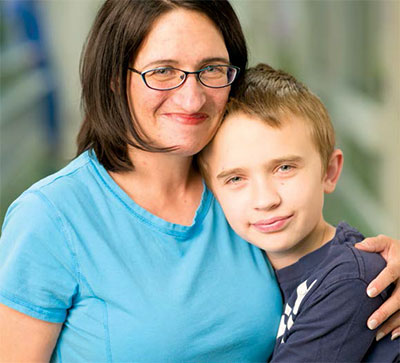From Bedside to Bench and Back Again

Scientific inspiration is fickle. It can’t be summoned or forced. Often the most actionable insights come wrapped in the unexpected. For Steven Bleyl, M.D., Ph.D., a medical geneticist, it came in the form of an infant admitted to the NICU with several birth defects. The family’s medical history didn’t point to any known genetic clues, but it was riddled with atrial fibrillation (AFib). This abnormal heart rhythm affects more than 3 million Americans, but it usually occurs in older people. It rarely runs in families. Was it genetic in her family, the baby’s mother wondered, and could finding the faulty gene help her child’s treatment and prognosis? Bleyl was intrigued and emailed her question to pediatric cardiologist Martin Tristani-Firouzi, M.D., a young clinician-scientist studying arrhythmias. “It was a great question,” recalls Tristani-Firouzi. “I just didn’t have the resources to be assured we’d find an answer.”
That was six years ago. Tristani-Firouzi was just getting his lab started. Like most physician-scientists – a rare and increasingly valuable breed – he straddles two worlds: he uses the tools of basic science to push medicine, but grounds scientific inquiry in his experience caring for patients. It’s gritty, groundbreaking work. Comparing the 3 billion base pairs of DNA found in every human genome has been likened to looking for one misspelled word in all the books in the Library of Congress. Tristani-Firouzi had at his disposal state-of-the-art sequencing facilities and the medical, public health and genealogical records of 7.3 million people housed within the Utah Population Database (UPDB). The database, the world’s largest of its kind, works like a magnifying glass for scientists to spot genes based on their transmission of disease across generations. “We had the families, the personal interest and the technology. All the pieces were in place. What was missing was the money,” says Tristani-Firouzi.
He put the project aside, but by 2012 the cost of sequencing had plummeted, new funding had become available, and new analysis tools made finding troublemaker genes much more promising. With a $50,000 grant from the Utah Genome Project, Tristani-Firouzi began looking for answers to questions posed years prior by the family of that tiny baby. His team sequenced three families: relatives of the infant and other patients with high rates of early-onset arrhythmia. To analyze the data, they used a new software algorithm developed by biomedical informatics expert and genetics professor Mark Yandell, Ph.D., that ranks genes according to their likelihood of stirring trouble. Within minutes, the software identified that two of the families shared changes in a gene that had already been linked to AFib and an inherited arrhythmia known as Long QT syndrome. In the third family, it uncovered a new gene linked to AFib.
Because two of the families lived in Utah and shared the same mutation, they were almost certainly related, but it was unclear how. Finding the familial relationship was critical because their ancestors likely had passed the gene to branches of the family residing in other parts of the country or world. “This gene might explain a large proportion of young-onset atrial fibrillation,” says Tristani-Firouzi. One family member supplied names and birth dates of distant relatives. Ken Smith, Ph.D., director of the UPDB, filled in the blanks. “It’s like detective work. We know these two families are related. But where’s the branch that connects them?” Smith says. The team built a pedigree of thousands tracing back to a European couple in the 1800s. Nearly 50 of the family’s descendants have atrial fibrillation, Long QT syndrome, or both.
If early diagnosis is important for atrial fibrillation patients, it’s absolutely critical with Long QT syndrome, which often goes unnoticed until someone dies of sudden cardiac arrest. Both diseases can be diagnosed with an electrocardiogram and treated with medicine or surgery. Tristani-Firouzi is reaching out to individuals identified through UPDB as having one of these conditions and encouraging them to contact siblings and children. “It’s a delicate conversation,” Tristani- Firouzi says. Jerry Jou, D.O., Ph.D., a pediatric cardiologist, often follows up by driving to the patients’ homes with an electrocardiography device to make diagnosis convenient, and blood tubes and consent forms to fuel further research. They can’t tell the families how they’re related because of federal privacy laws. But the information they can share might just save their lives.


